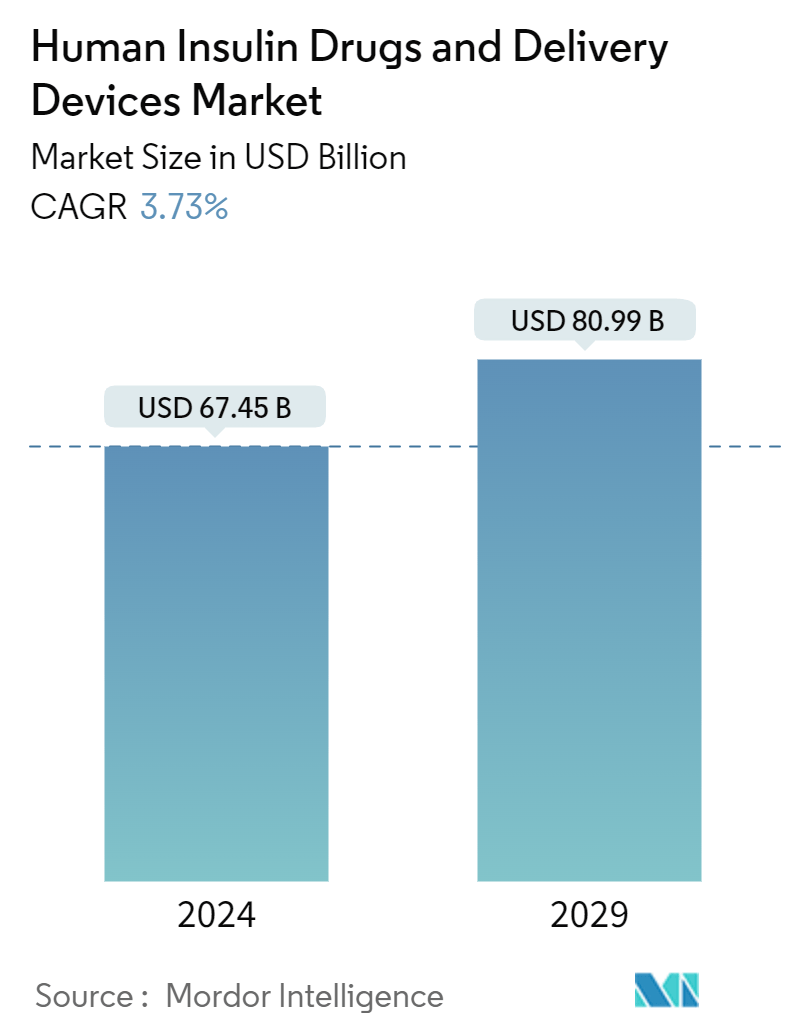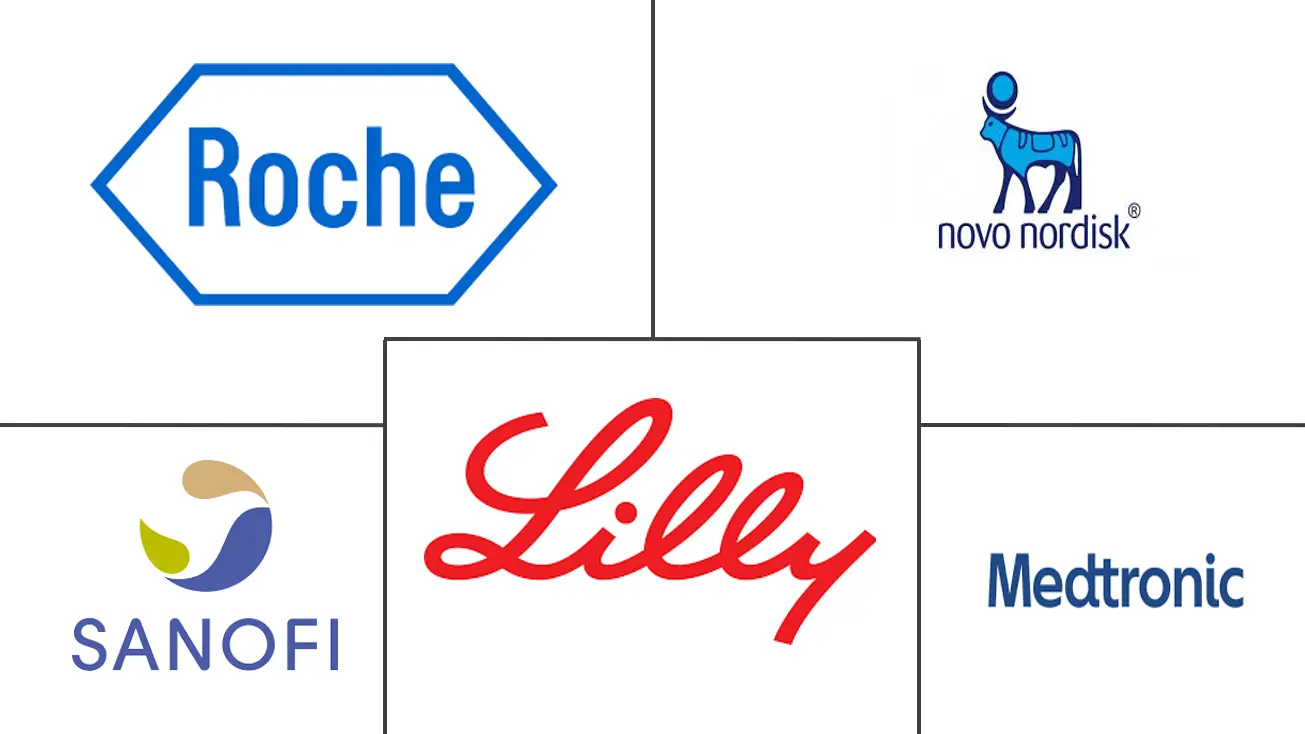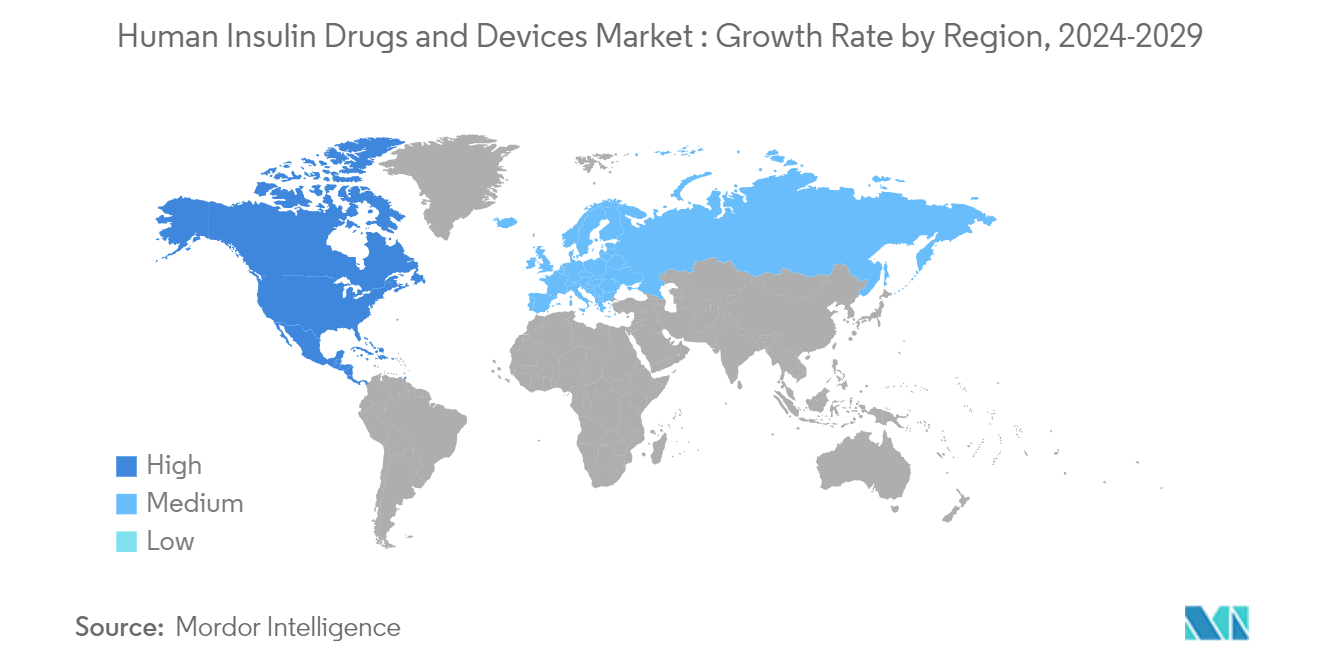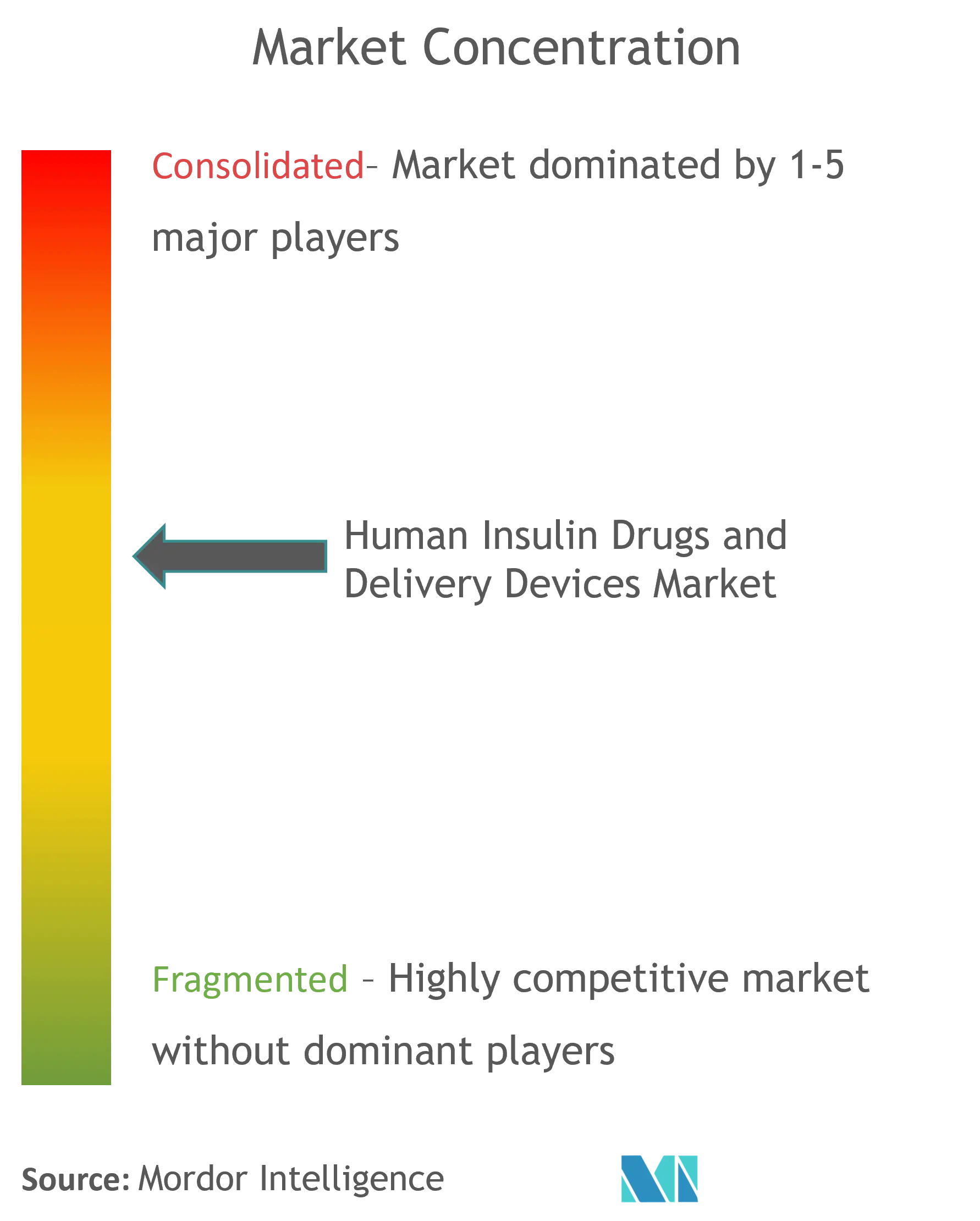Human Insulin Drug and Delivery Device Market Size

| Study Period | 2018 - 2029 |
| Market Size (2024) | USD 67.45 Billion |
| Market Size (2029) | USD 80.99 Billion |
| CAGR (2024 - 2029) | 3.73 % |
| Fastest Growing Market | Asia Pacific |
| Largest Market | North America |
Major Players
*Disclaimer: Major Players sorted in no particular order |
Human Insulin Drug and Delivery Device Market Analysis
The Human Insulin Drugs And Delivery Devices Market size is estimated at USD 67.45 billion in 2024, and is expected to reach USD 80.99 billion by 2029, growing at a CAGR of 3.73% during the forecast period (2024-2029).
Diabetes is generally considered a lifestyle-related disease. Over time, with the increase in population around the world, the incidences of the disease have increased outrageously. Approximately 100 million people around the world need insulin, including all the people suffering from Type 1 diabetes and between 10-25% of people with Type 2 diabetes. Although insulin has been used in the treatment of diabetes for over 90 years, globally, more than half of those who need insulin today still cannot afford and access it.
The global increase in the population affected by type 1 diabetes has spurred significant growth in the insulin drugs and device market. Type 1 diabetes, characterized by the body's inability to produce insulin, affects millions of individuals worldwide, and its prevalence is on the rise. Factors such as sedentary lifestyles, unhealthy dietary habits, and genetic predispositions contribute to this upward trend.
With the expanding diabetic population, there is a growing demand for insulin medications and delivery devices to manage the condition effectively. Insulin remains the cornerstone of treatment for type 1 diabetes, as well as for some individuals with type 2 diabetes who require insulin therapy. As a result, pharmaceutical companies are investing in research and development to innovate new insulin formulations and delivery systems that offer improved efficacy, convenience, and safety for patients.
Moreover, advancements in technology have led to the development of insulin pumps, continuous glucose monitoring (CGM) systems, and artificial pancreas devices, which provide more precise insulin dosing and better glycemic control. These innovations have transformed diabetes management, empowering patients to lead more flexible and active lifestyles while reducing the risk of hypoglycemia and other complications.
The increasing prevalence of type 1 diabetes, coupled with advancements in insulin therapies and delivery devices, is expected to continue driving the growth of the insulin drugs and device market in the years to come. This growth presents opportunities for pharmaceutical companies, medical device manufacturers, and healthcare providers to collaborate in delivering innovative solutions that improve the quality of life for individuals living with diabetes.
Insulin Drugs and delivery devices are necessary for type-1 diabetes patients because their body doesn't produce insulin internally, type-2 diabetes patients also need insulin, particularly those who have difficulty controlling their diabetes with oral medications.
Human Insulin Drug and Delivery Device Market Trends
Type-1 Diabetes Population Driving the Market In The Forecast Period
The type-1 diabetes population is expected to register a CAGR of over 2% during the forecast period.
The exact cause of type-1 diabetes is unknown, but type-2 diabetes is caused by day-to-day lifestyle changes and choices. The prevalence rate of type-2 diabetes has quadrupled when compared to a decade ago. The prevalence of type-1 diabetes mellitus (T2DM) has increased dramatically during the last two decades, a fact driven by the increased incidence of obesity, the primary risk factor for T1DM. Diabetes ranks among the fastest-growing chronic diseases in the United States. India is among the top three countries with a high incidence of diabetes. Many reports and surveys have documented a drastic increase in the diabetic population based on lifestyle habits.
Although oral anti-diabetic drugs are considered a standard of care for type-2 diabetes patients, there has been a rise in the need for using insulin, along with conventional medication, to help stabilize blood glucose levels. This trend has attracted many players, both local and international, to enter the biosimilar market.
The R&D in the insulin segment is rising year-on-year as researchers are trying to bring out the best molecule for patients' use, curb maximum side effects, and increase their efficiency. Thus, the increasing prevalence of obesity and diabetes across the world is likely to augment the demand for insulin, which in turn drives the market for insulin drugs and devices.

North America is Expected to Dominate the Human Insulin Drugs and Delivery Devices Market.
North America dominates the human insulin drug and delivery device market, despite having high insulin prices. According to RAND researchers, insulin drug companies charge more for insulin in the United States than in any other country. Insulin drug companies say that the price is based on government regulations and insurance providers.
For the insured, out-of-pocket costs are usually calculated as a percentage of co-insurance of the list price of insulin products. Increases in patient co-insurance, therefore, reflect rising list prices of insulin products. According to a Commonwealth Fund study, uninsured Americans with diabetes are more likely to be using older, less costly (and less effective) insulin drugs compared to those with private insurance or Medicaid. 60% to 80% of uninsured patients pay the full list price for insulin, while 9% of privately insured patients and 3% of Medicaid beneficiaries do.
Despite all these factors, the market for insulin drugs and delivery devices is high in North America because there is no other major option other than insulin. There have been several initiatives carried out in the commercial sector to address insulin affordability. The recent advent of biosimilar insulin products may help reduce out-of-pocket costs, as could the possibility of automatic interchangeability between biosimilar insulin and originator products.
Thus, owing to the above factors, it is expected to drive market growth over the forecast period.

Human Insulin Drug and Delivery Device Industry Overview
The market is highly consolidated, with three major manufacturers holding a global market presence and the remaining manufacturers confined to other local or region-specific manufacturers. Mergers and acquisitions that happened between the players in the recent past have helped the companies strengthen their market presence. Eli Lilly and Boehringer Ingelheim have an alliance to develop and commercialize Basaglar (Insulin Glargine). Additionally, the players in the recent past helped the companies strengthen their market presence; for example, Novo Nordisk collaborated with Ypsomed to provide better insulin therapy solutions.
Human Insulin Drug and Delivery Device Market Leaders
-
Novo Nordisk
-
Sanofi
-
El lilly
-
Medtronics
-
Roche
*Disclaimer: Major Players sorted in no particular order

Human Insulin Drug and Delivery Device Market News
- May 2023: The U.S. Food and Drug Administration cleared the Beta Bionics iLet ACE Pump and the iLet Dosing Decision Software for people six years of age and older with type 1 diabetes. These two devices, along with a compatible FDA-cleared integrated continuous glucose monitor (iCGM), will form a new system called the iLet Bionic Pancreas. This new automated insulin dosing (AID) system uses an algorithm to determine and command insulin delivery.
- October 2022: Novo Nordisk announced headline results from the ONWARDS 5 phase 3a trial with once-weekly insulin icodec in people with type 2 diabetes. The ONWARDS 5 trial was a 52-week, open-label efficacy, and safety treat-to-target trial investigating once-weekly insulin versus once-daily basal insulin (insulin degludec or insulin glargine U100/U300).
Human Insulin Drug and Delivery Device Market Report - Table of Contents
1. INTRODUCTION
- 1.1 Study Assumptions and Market Definition
- 1.2 Scope of the Study
2. RESEARCH METHODOLOGY
3. EXECUTIVE SUMMARY
4. MARKET DYNAMICS
- 4.1 Market Overview
- 4.2 Market Drivers
- 4.3 Market Restraints
-
4.4 Industry Attractiveness - Porter's Five Forces Analysis
- 4.4.1 Threat of New Entrants
- 4.4.2 Bargaining Power of Buyers/Consumers
- 4.4.3 Bargaining Power of Suppliers
- 4.4.4 Threat of Substitute Products
- 4.4.5 Intensity of Competitive Rivalry
5. MARKET SEGMENTATION
-
5.1 By Drug
- 5.1.1 Basal or Long Acting Insulins
- 5.1.1.1 Lantus (Insulin glargine)
- 5.1.1.2 Levemir (Insulin detemir)
- 5.1.1.3 Tresiba (Insulin degludec)
- 5.1.1.4 Toujeo (Insulin glargine)
- 5.1.1.5 Basaglar (Insulin glargine)
- 5.1.2 Bolus or Fast Acting Insulins
- 5.1.2.1 NovoRapid/Novolog (Insulin aspart)
- 5.1.2.2 Humalog (Insulin lispro)
- 5.1.2.3 Apidra (Insulin glulisine)
- 5.1.2.4 FIASP (Insulin aspart)
- 5.1.2.5 Admelog (Insulin lispro Sanofi)
- 5.1.3 Traditional Human Insulins
- 5.1.3.1 Novolin/Mixtard/Actrapid/Insulatard
- 5.1.3.2 Humulin
- 5.1.3.3 Insuman
- 5.1.4 Combination Insulins
- 5.1.4.1 NovoMix (Biphasic Insulin aspart)
- 5.1.4.2 Ryzodeg (Insulin degludec and Insulin aspart)
- 5.1.4.3 Xultophy (Insulin degludec and Liraglutide)
- 5.1.4.4 Soliqua/Suliqua (Insulin glargine and Lixisenatide)
- 5.1.5 Biosimilar Insulins
- 5.1.5.1 Insulin glargine biosimilars
- 5.1.5.2 Human insulin biosimilars
-
5.2 By Device
- 5.2.1 Insulin Pumps
- 5.2.1.1 Insulin Pump Devices
- 5.2.1.2 Insulin Pump Reservoirs
- 5.2.1.3 Insulin Infusion sets
- 5.2.2 Insulin Pens
- 5.2.2.1 Cartridges in reusable pens
- 5.2.2.2 Disposable insulin pens
- 5.2.3 Insulin Syringes
- 5.2.4 Insulin Jet Injectors
-
5.3 Geography
- 5.3.1 North America
- 5.3.1.1 United States
- 5.3.1.2 Canada
- 5.3.1.3 Rest of North America
- 5.3.2 Europe
- 5.3.2.1 Germany
- 5.3.2.2 United Kingdom
- 5.3.2.3 France
- 5.3.2.4 Russia
- 5.3.2.5 Spain
- 5.3.2.6 Italy
- 5.3.2.7 Rest of Europe
- 5.3.3 Asia-Pacific
- 5.3.3.1 Australia
- 5.3.3.2 India
- 5.3.3.3 China
- 5.3.3.4 Japan
- 5.3.3.5 Malaysia
- 5.3.3.6 South Korea
- 5.3.3.7 Thailand
- 5.3.3.8 Philippines
- 5.3.3.9 Vietnam
- 5.3.3.10 Indonesia
- 5.3.3.11 Rest of the Asia-Pacific
- 5.3.4 Latin America
- 5.3.4.1 Brazil
- 5.3.4.2 Mexico
- 5.3.4.3 Rest of Latin America
- 5.3.5 Middle-East and Africa
- 5.3.5.1 Saudi Arabia
- 5.3.5.2 Iran
- 5.3.5.3 Egypt
- 5.3.5.4 Oman
- 5.3.5.5 South Africa
- 5.3.5.6 Rest of the Middle-East and Africa
6. MARKET INDICATORS
- 6.1 Type-1 diabetes population
- 6.2 Type-2 diabetes population
7. COMPETITIVE LANDSCAPE
-
7.1 Company Profiles
- 7.1.1 Novo Nordisk A/S
- 7.1.2 Sanofi Aventis
- 7.1.3 Eli Lilly
- 7.1.4 Biocon
- 7.1.5 Julphar
- 7.1.6 Exir
- 7.1.7 Medtronic
- 7.1.8 Insulet
- 7.1.9 Ypsomed
- 7.1.10 Becton Dickinson
- *List Not Exhaustive
- 7.2 Company Share Analysis
8. MARKET OPPORTUNITIES AND FUTURE TRENDS
** Subject To AvailablityHuman Insulin Drug and Delivery Device Industry Segmentation
The hormone class of drugs includes human insulin. In place of the insulin that the body ordinarily produces, human insulin is used. It assists in the movement of blood sugar into different bodily tissues, where it is used as an energy source. It also prevents the liver from generating additional sugar. The human insulin drug and delivery device market is segmented by type, device type, and geography. The report offers the value (in USD) and volume (in units) for the above segments.
| By Drug | Basal or Long Acting Insulins | Lantus (Insulin glargine) |
| Levemir (Insulin detemir) | ||
| Tresiba (Insulin degludec) | ||
| Toujeo (Insulin glargine) | ||
| Basaglar (Insulin glargine) | ||
| By Drug | Bolus or Fast Acting Insulins | NovoRapid/Novolog (Insulin aspart) |
| Humalog (Insulin lispro) | ||
| Apidra (Insulin glulisine) | ||
| FIASP (Insulin aspart) | ||
| Admelog (Insulin lispro Sanofi) | ||
| By Drug | Traditional Human Insulins | Novolin/Mixtard/Actrapid/Insulatard |
| Humulin | ||
| Insuman | ||
| By Drug | Combination Insulins | NovoMix (Biphasic Insulin aspart) |
| Ryzodeg (Insulin degludec and Insulin aspart) | ||
| Xultophy (Insulin degludec and Liraglutide) | ||
| Soliqua/Suliqua (Insulin glargine and Lixisenatide) | ||
| By Drug | Biosimilar Insulins | Insulin glargine biosimilars |
| Human insulin biosimilars | ||
| By Device | Insulin Pumps | Insulin Pump Devices |
| Insulin Pump Reservoirs | ||
| Insulin Infusion sets | ||
| By Device | Insulin Pens | Cartridges in reusable pens |
| Disposable insulin pens | ||
| By Device | Insulin Syringes | |
| Insulin Jet Injectors | ||
| Geography | North America | United States |
| Canada | ||
| Rest of North America | ||
| Geography | Europe | Germany |
| United Kingdom | ||
| France | ||
| Russia | ||
| Spain | ||
| Italy | ||
| Rest of Europe | ||
| Geography | Asia-Pacific | Australia |
| India | ||
| China | ||
| Japan | ||
| Malaysia | ||
| South Korea | ||
| Thailand | ||
| Philippines | ||
| Vietnam | ||
| Indonesia | ||
| Rest of the Asia-Pacific | ||
| Geography | Latin America | Brazil |
| Mexico | ||
| Rest of Latin America | ||
| Geography | Middle-East and Africa | Saudi Arabia |
| Iran | ||
| Egypt | ||
| Oman | ||
| South Africa | ||
| Rest of the Middle-East and Africa |
Human Insulin Drug and Delivery Device Market Research FAQs
How big is the Human Insulin Drugs And Delivery Devices Market?
The Human Insulin Drugs And Delivery Devices Market size is expected to reach USD 67.45 billion in 2024 and grow at a CAGR of 3.73% to reach USD 80.99 billion by 2029.
What is the current Human Insulin Drugs And Delivery Devices Market size?
In 2024, the Human Insulin Drugs And Delivery Devices Market size is expected to reach USD 67.45 billion.
Who are the key players in Human Insulin Drugs And Delivery Devices Market?
Novo Nordisk, Sanofi, El lilly, Medtronics and Roche are the major companies operating in the Human Insulin Drugs And Delivery Devices Market.
Which is the fastest growing region in Human Insulin Drugs And Delivery Devices Market?
Asia Pacific is estimated to grow at the highest CAGR over the forecast period (2024-2029).
Which region has the biggest share in Human Insulin Drugs And Delivery Devices Market?
In 2024, the North America accounts for the largest market share in Human Insulin Drugs And Delivery Devices Market.
What years does this Human Insulin Drugs And Delivery Devices Market cover, and what was the market size in 2023?
In 2023, the Human Insulin Drugs And Delivery Devices Market size was estimated at USD 64.93 billion. The report covers the Human Insulin Drugs And Delivery Devices Market historical market size for years: 2018, 2019, 2020, 2021, 2022 and 2023. The report also forecasts the Human Insulin Drugs And Delivery Devices Market size for years: 2024, 2025, 2026, 2027, 2028 and 2029.
Human Insulin Industry Report
Statistics for the 2024 Human Insulin market share, size and revenue growth rate, created by Mordor Intelligence™ Industry Reports. Human Insulin analysis includes a market forecast outlook 2029 and historical overview. Get a sample of this industry analysis as a free report PDF download.



